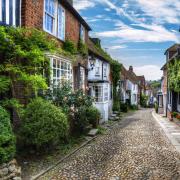From the rolling dunes of West Wittering to the pebbles at Pelham, Sussex has some of the best beaches in Britain. That’s why tourists have been flocking here since the 1700s – first royalty and the wealthy and then en masse with the invention of the railway in the 1840s – taking in lungfuls of salty sea air as a cure-all for their city ailments.
But which one is the best? Ian Brighouse has spent the last 12 years journeying around the coast trying to find out for The British Beach Guide. A celebration of our coast, he has travelled the length and breadth of the British Isles from the remote wilderness of Cullykhan in Aberdeenshire to the thriving working harbour at St Ives in Cornwall visiting more than 130 of Britain’s beaches creating this definitive tome - and his quest continues.
But this is a guide with a difference. Rather than just picking his own favourites, Ian has asked beachgoers for their highlights which make up the fascinating guide along with photographs, impressions and information about the special places where the land, sea and sky meet.
‘It seems that people prefer unspoilt, undeveloped beaches and there’s also an important link through the generations,’ Ian says.
‘Regional characteristics also distinguish beaches; long granite headlands feature in Cornwall and Pembrokeshire, with the sea often viewed closely from the side, whereas big skies and migratory birds have a resonant impact in Norfolk and Suffolk. People’s relationship with nature is starkly visible through the inshore fishing communities of Cornwall, Suffolk, Sussex and Cornwall, not forgetting Cornwall’s surfers and wild swimmers. There’s a wide diversity of beach use in these islands.’

On his journey Ian has learnt how the beach means different things to different people, whether it’s enhancing creativity, decisiveness and energy, being restorative and settling, part of a routine, freedom or just fun.
‘The beach is a wonderful place for us all to enjoy,’ he says. ‘Its’ ever-changing nature, whether on a daily or tidal basis or through the seasons, guarantees an element of anticipation and excitement in any beach visit.’
Ian believes people are at their happiest on the beach and many were happy to talk. These were all strangers and the interviews were not pre-arranged, yet the answers came thick and fast. Secondly, the range of answers was as diverse as the moods of the sea. ‘You just don’t know what you’ll see and who you’ll meet when you go to the beach, meaning that you’ll always have a different answer to the question: “What does the beach mean to you?”’
Here's what Ian and the beachgoers of Sussex said about four of our best-known beaches...

WEST WITTERING
The most westerly of the Sussex beaches, West Wittering is also one of the most beautiful, with uncharacteristically soft sand and a fine view across The Solent to the Isle of Wight. There are picturesque dunes behind the beach, which is a popular escape from Chichester and further beyond. I remember on one occasion the weather was mild and dry and the tide was low enough to enjoy shell hunting in the flat, lower reaches. Another time the sun was out during an autumn visit. On a low tide with a warm breeze from the southwest, my beach walk was mild and reflective. Looking across to Hayling Island and the Isle of Wight, I wondered at the trade in and out of Southampton over the years and the natural beauty on this side of the water.
What does the beach mean to you?
Peter: ‘To me, the beach is where civilisation and developed places meet the wild. On the land here, it’s relatively untamed, but obviously it’s inhabited, and it’s been moulded and shaped by people, but when you look out to the sea, it’s completely wild. Wherever you are, there’s absolutely nothing you could do to change it. It’s its own thing and it’s where you can come, at any stage, to get a view of the wild.’
Tom: ‘I think it’s relaxing. I like the sound of the waves. It’s a place where I can chill out, more than anything. It’s not far from home, so it’s nice and easy to get to.’

ROTTINGDEAN
Picturesque Rottingdean lies off the busy tourist trail. It’s a small, picture-perfect town with a historic past and a friendly welcome. The main features in the town are Kipling’s Garden, Rottingdean Windmill and St. Margaret’s Church, with its beautiful stained-glass windows. There are some traditional old inns which were once frequented by smugglers in the area due to the remoteness of the town and its proximity to the sea.
The beach itself is relatively secluded and backed by strikingly high chalk cliffs. Rottingdean has its own micro-climate. Facing south and in the lea of cool northerly breezes, the high white cliffs reflect and radiate the sun onto the beach and the promenade below. I remember one visit when the tide was high, the waves were wild and the winter sun was bright in the sky. The stylish performance stage near the beach pays respect to the folk singing Copper family from Rottingdean. It makes you want to linger here in the hope of a tune. Out beyond the beach at low tide are white chalk pavements formed by the erosion that is a permanent feature of this part of the coast.
What does the beach mean to you?
Gail: ‘It’s so beautiful along here, this whole stretch, that I just feel I have to make use of it. I think it does me good, in terms of tranquillity and putting my life back into some kind of perspective. I moved down here ten years ago and it’s the best thing I ever did. Its’ beauty, its’ wildness - it’s serene in my ways, although it’s wild and it’s just makes my life complete.’
Regine: ‘For me, it’s very relaxing. I’ve been living by the beach for the last 40years. It’s always different. The colours are different. It’s good exercise too.’
SELSEY BILL
Inshore boats still bring whelks, crab and lobster ashore at Selsey Bill. Traceable generations of the family of Norman James Woodland have been fishing at Selsey Bill for 932 years, an unbroken chain that other families can also claim. Due to the treacherous nature of the sea around the Bill, there is also a lifeboat stationed here. The western shoreline at Selsey Bill is being protected and managed in two ways, with the West Sands Coastal Protection Scheme guarding the beach at the Holiday Park and the Medmerry Managed Realignment Scheme being developed by the Environment Agency, using a policy of managed retreat in the face of the sea. That beach is on Manhood Peninsula, the most southerly tip of West Sussex. My visit was to the eastern beach.
What does the beach mean to you?
Norman: ‘This is a working beach, 53 years of fishing for me. I used to go with my father before I left school in the spring to row, because you couldn’t use an engine in those days, to catch prawns before they vanished again into deeper water. The big boats used to carry a pair of oars and sails. My father’s big boat was 28 foot, a ship’s lifeboat. She had a Kelvin engine in her and she was petrol and paraffin.’
David: ‘Fishing took my interest at a young age and has done ever since. Now, in my mid-fifties, it’s getting harder, but I still love the job. You are your own boss. We have small boats on the beach and we use them to get off to the larger ones offshore. Sometimes, it’s not too easy getting off, on days when it’s rough on the shore. On days when it’s lovely and calm, you couldn’t have a better job.’

HASTINGS
Pelham is the main beach in Hastings, facing southeast and made largely of shingle. Much of this beach has been created from land reclaimed from the sea. With the advent of the railways in the 19th century more tourists arrived in Hastings, requiring greater beach space. As well as being a popular visitor attraction due to its proximity to Battle, this is the main Cinque Port in East Sussex. It enjoys both a proud Royal Charter and has a strong fishing tradition, including a healthy, thriving Sea Angling Association. The inshore fishing fleet lands a varied catch, the Senlac Jack bringing home cuttlefish and some Dover sole on one of my visits. On their return from the sea, boats of up to 18 tons are hauled up the beach by caterpillar tractors.
What does the beach mean to you?
Paul: ‘It’s our working environment. We work from the open beach. We are commercial fishermen. It’s a very old fleet. We have been here over a thousand years and some families date back that far, so the beach is where we are working, day to day. The rights of the open beach for the fishermen here are from a charter from when they were conscripted and fought against The Spanish Armada.’
Pete: ‘It means everything. It’s family related. Me and my brother over there, we have been doing it (fishing) since we were nippers. It’s in your blood. It’s in your veins.’
The British Beach Guide by Ian Brighouse is available from the Whittles Publishing website, as well as all good bookshops and online retailers, priced at £18.99.




























